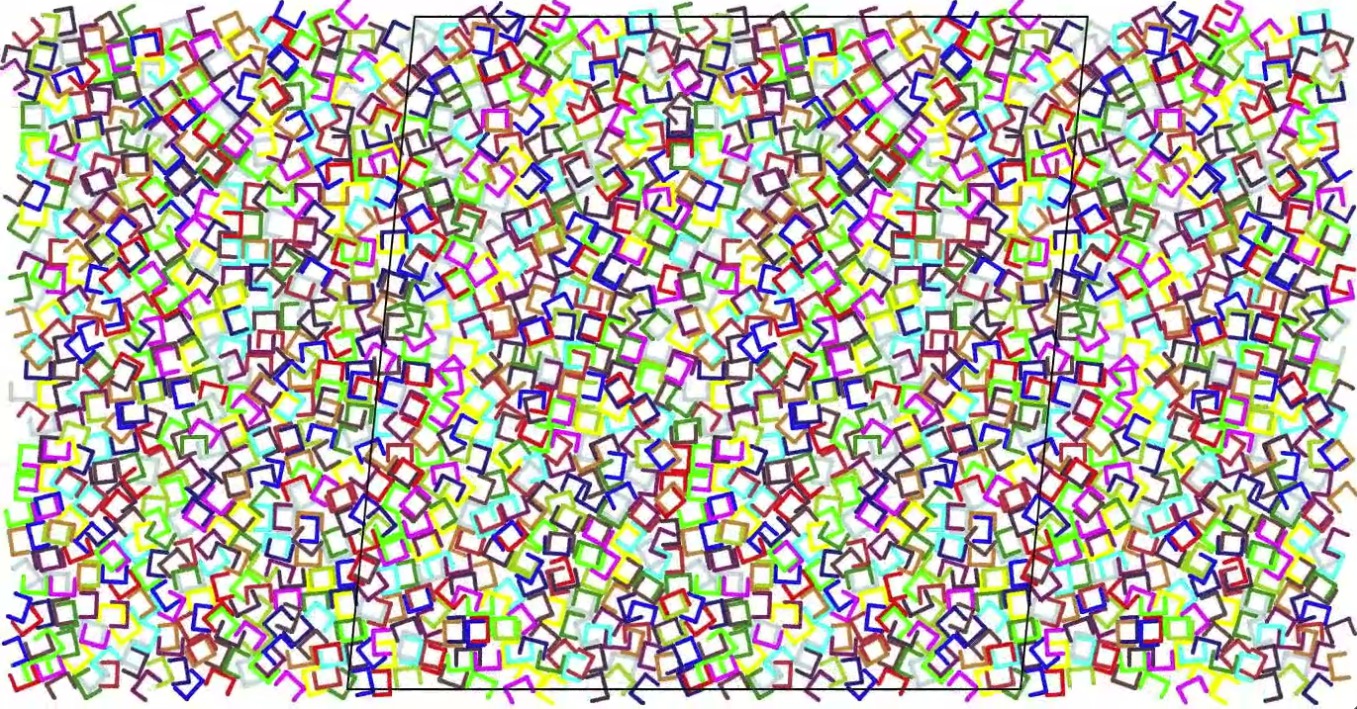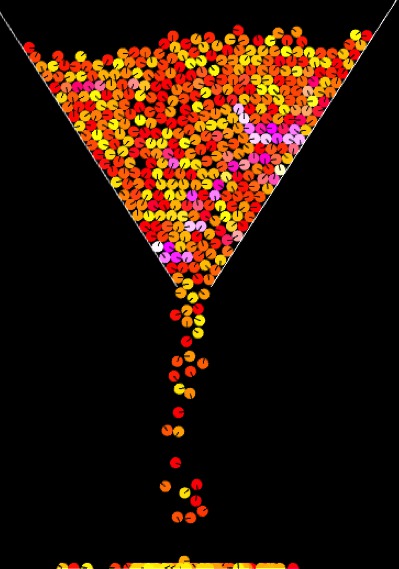Reports: UR1051438-UR10: Geometrically Cohesive Granular Materials: Experiment and Simulation
Scott Victor Franklin, Rochester Institute of Technology
Impact on students
This year saw four undergraduates join the lab. Three were supported
directly by this project. One received direct support from the
National Science Foundation but shared capital equipment (a laser
cutter) partially funded by this project. Three students are working
on experiments, including two described here, while the fourth has
learned GPU programming and developed the simulations discussed below.
Frictionless Spherostaples
The primary accomplishment was the development of a simulation of
sheared, 2d "spherostaples." These particles are comprised of three
spherocylinders (cylinders with hemispherical endcaps) attached at the
ends to form a "U" shape. Figure 1 shows a snapshot of the
simulation. Because the contact of spherocylinders can be resolved
analytically (it's essentially the nearest distance between finding
two line segments), resolving contact of spherostaples is
computationally efficient and lends itself to parallelization. It had
been hypothesized that the entangling nature of the spherostaples
would mirror dry friction, and so the frictionless system would
display a discontinuous shear stress as a function of strain-rate and
packing fraction. We find no such behavior, however, with the stress
behavior behaving very much like that in sheared frictionless
disks. Subsequent work is focusing on the rotational diffusion of the
particles.

Figure 1: 2d sheared system of
spherostaples. Particles are comprised of spherocylinders (cylinders
with hemispherical endcaps) enabling a computationally efficient
contact algorithm.
Frictional disk systems
The 2d spherostaple code
applied Lees-Edwards boundary conditions to an overdamped system. We
have since developed more conventional discrete-element molecular
dynamics simulations that allow for particle inertia and realistic
frictional models. Simulations are running on a new Dual NVIDIA Quadro
K5000 machine. Each GPU has 1536 cores, and our algorithm allocates a
thread to each particle contact. We have developed simulations for two
distinct geometries: simple shear and hopper flow.
Pure Shear
Shear simulations will be compared with an annular-planar Couette
experiment. The Couette cell is made up of two concentric cylinders,
with particles cut from acrylic or Teflon with a new laser cutter
(purchased with grant funds). Figure 2 (left) shows an image of the
simulation, with 8192 particles undergoing simple shear. Figure 2
(right) is an image from the experiment. Because the cell radius is
significantly larger that the particle size, the experiment is
essentially a 2d simple shear geometry, thus enabling a direct
comparison. Both simulation and experiment use a binary mixture of
disks; a mixture of particle sizes to prevent crystallization. Six
equally spaced cameras enable us to visualize the entire experimental
cell and track all particle motion up to arbitrarily large shear.
We are currently looking at particulate level motions, characterizing
particle rearrangements by their non-affinity and induced quadrupole
moment in the displacement field. Once analysis software has been
developed, we will introduce a small number of spherocylinders and
track their rotation and diffusion in the sea of circular disks. A
critical question concerns the behavior of the elongated particles
once their concentration becomes large enough for them to interact
directly. Whether their entanglement inhibits or facilitates alignment
is an outstanding question important to industrial applications
involving such particles.


Figure 2: Left: 2d discrete-element
molecular dynamics simulation of 8192 frictional disks in simple
shear. Right: Experimental annular-planar Couette cell. 6
cameras have been used to obtain a full 360 image.
Hopper Flow
Hopper simulations will be compared with a new experiment on the flow
of sand through random packings of larger spheres. The sphere packings
creates a network of voids through which the smaller sand flows, and
we model the network as a distribution of hopper apertures, which can
jam and unjam dynamically with time. Figure 3 (left) shows a
simulation of 512 particles falling through a single hopper
aperture. Figure 3 (right) shows exit mass vs. time data for sand
flowing through a fixed bead pack. The initial linear behavior
results, we believe, from a Janssen effect in which the pressure on
the exiting sand is constant. As the amount of sand in the pack goes
to zero, the Janssen effect gives way to a more hydrostatic-like
pressure. We are currently studying how this behavior depends on the
relative sand and bead size, as well as size of the bead pack itself,
which may affect the void size distribution.


Figure 3: Left: 2d discrete-element
molecular dynamics simulation of 512 frictional disks flowing through
a hopper. Right: Experimental exit mass vs. time data of sand
flowing through a random packing of larger spheres.
Future work
This year will be spent primarily with three undergraduate
researchers. One will take data from the annular-planar Couette
experiment, the second studying the drainage of sand through a bead
pack, while the third will run and analyze matching simulations. All
three spent the summer setting up their project, and so are now ready
to take and analyze data.











